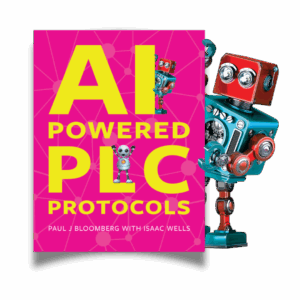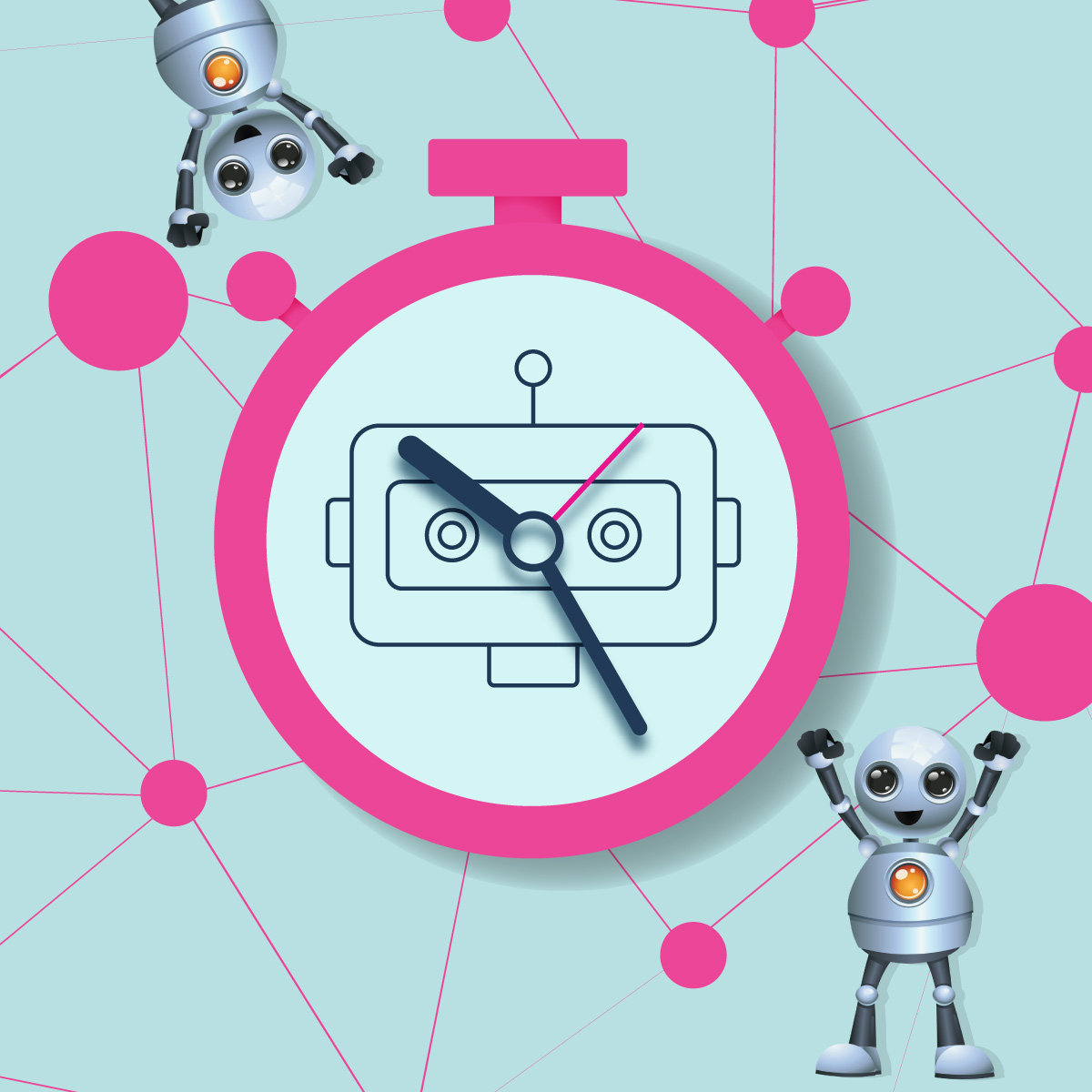 Together, my co-author and friend Isaac Wells and I are driven by one obsession: helping teachers reclaim time and helping students grow through the power of self- and peer-assessment. For over 15 years, we’ve worked side-by-side in schools across the country, refining PLC practices so teachers can spend less time on paperwork and more time on what matters—students. Our forthcoming book, AI-Powered PLC Protocols (Bloomberg & Wells, 2025), is the culmination of that work. Every protocol in the book is built on the EAA framework (Evidence → Analysis → Action), so all AI outputs are actionable, equity-centered, and student-facing.
Together, my co-author and friend Isaac Wells and I are driven by one obsession: helping teachers reclaim time and helping students grow through the power of self- and peer-assessment. For over 15 years, we’ve worked side-by-side in schools across the country, refining PLC practices so teachers can spend less time on paperwork and more time on what matters—students. Our forthcoming book, AI-Powered PLC Protocols (Bloomberg & Wells, 2025), is the culmination of that work. Every protocol in the book is built on the EAA framework (Evidence → Analysis → Action), so all AI outputs are actionable, equity-centered, and student-facing.
The following two protocols show just how much time schools can reclaim: Unpacking for Clarity and the Analysis of Evidence (AOE).
AI-Powered Unpacking for Clarity: Hours → Minutes
In a traditional PLC, unpacking a standard is slow work. Teachers pull apart the verbs, identify knowledge and skills, brainstorm learning targets, and sketch possible success criteria. It can take an hour or more just to get consensus—and that’s before testing whether the targets are student-friendly.
With the AI Unpacking for Clarity Protocol (see Protocol Book, Section 2 and expanded in AI-Powered PLC Protocols, 2025), AI drafts the entire EAA cycle in seconds:
- Evidence: Deconstructs the verbs and nouns in the standard (~10 minutes traditionally).
- Analysis: Suggests learning targets at surface, deep, and transfer levels (~20 minutes traditionally).
- Action: Generates student-facing outputs including:
-
- “I can” statements
- Success criteria and a draft rubric
- Surface, deep, and transfer questions
- Draft learning progressions
- Possible misconceptions tied to the standard
- Tier 1 strategies to address misconceptions
Instead of spending an hour drafting, PLCs spend 10–15 minutes refining. The time saved is re-allocated to what matters: checking if the AI missed cultural or linguistic context, adjusting rigor, and ensuring equity.
AI gives us the clay. Teachers do the sculpting. (Bloomberg & Wells, 2025)
AI-Powered AOE: Hours → Instant Outputs
The AOE Protocol is the heartbeat of Impact Teams (see AI-Powered PLC Protocols, Part 2). Traditionally, it’s also the most time-intensive. Teachers and facilitators spend hours collecting, organizing, and drafting just to prepare for discussion.
With Auto-Run AOE, the AI produces all eight outputs of the EAA framework in seconds:
- Evidence Table with code-named student artifacts
- Proficiency Banding (P → D → E → Ex)
- Coverage Map of success criteria
- Instructional Points for each band (I Do → We Do → Partner → You Do)
- UDL Supports to widen access
- ELL Scaffolds for multilingual learners
- Personalized, Asset-Based Feedback aligned to success criteria
- Mastery Goal + PLC Notes Export to guide next steps
What used to take well over an hour of manual work now lands on the table instantly. Instead of rushing through incomplete analysis, PLCs can spend the majority of their meeting deliberating together—checking accuracy, discussing equity, and choosing actions that matter for learners.
Time Savings at a Glance
Assumptions: A typical PLC cycle reviews ~25–30 student artifacts. Times reflect drafting/structuring work; facilitation dialogue remains essential.
Table U — Unpacking for Clarity (Detailed Outputs)
| Output | Traditional Time | AI-Powered Time | Time Saved | |
|---|---|---|---|---|
| Deconstruct verbs & nouns | ~10 min | Seconds | ~10 min | |
| Learning targets (surface, deep, transfer) | ~20 min | Seconds | ~20 min | |
| “I can” statements + success criteria/rubric | ~30 min | Seconds | ~30 min | |
| Surface/deep/transfer questions | ~10–15 min | Seconds | ~10–15 min | |
| Draft learning progressions | ~10–15 min | Seconds | ~10–15 min | |
| Possible misconceptions | ~10 min | Seconds | ~10 min | |
| Tier 1 strategies to address misconceptions | ~10–15 min | Seconds | ~10–15 min | |
| Total (thorough unpacking) | ~90–120 min | 10–15 min | ~75–110 min |
Many PLCs previously spent ~60 minutes by omitting questions, progressions, and misconception strategy mapping. The AI-Powered Unpacking for Clarity Protocol makes the full set feasible in a single pass. However, we use a Check In Protocol to evaluate the quality of AI and to ensure we personalize any artifact or tool to the students in our classroom.
Table AOE — Analysis of Evidence (All 8 Outputs)
| Output | Traditional Time | AI-Powered Time | Time Saved |
|---|---|---|---|
| Evidence table (code-named) | ~15 min | Seconds | ~15 min |
| Proficiency banding (P → D → E → Ex) | ~10 min | Seconds | ~10 min |
| Coverage map of success criteria | ~10 min | Seconds | ~10 min |
| Instructional points for each band (I Do → We Do → Partner → You Do) | ~20 min | Seconds | ~20 min |
| UDL supports | ~10 min | Seconds | ~10 min |
| ELL scaffolds | ~10 min | Seconds | ~10 min |
| Mastery goal + PLC notes export | ~15 min | Seconds | ~15 min |
| Subtotal (non-feedback) | ~90 min | 2–3 min | ~87–88 min |
| Personalized, asset-based feedback (25–30 students) | ~75–150 min (3–5 min per student) | ~12–30 min (30–60 sec per student) | ~63–120 min |
| AOE total (incl. feedback) | ~165–240 min | ~14–33 min | ~131–226 min |
Table B — Feedback at Scale (Per Student and 100 Students)
| Scope | Traditional Time | AI-Powered Time | Time Saved |
|---|---|---|---|
| Per student (personalized, asset-based feedback) | ~3–5 min | ~0.5–1.0 min | ~2–4 min |
| 100 students | ~300–500 min (5–8.3 hrs) | ~50–100 min (0.8–1.7 hrs) | ~200–450 min (3.3–7.5 hrs) |
Time Saved, Impact Gained
Across dozens of schools piloting these protocols, the results are consistent: each cycle gives PLCs back 90+ minutes to focus on authentic deliberation. That’s an entire block of time every week that used to be spent typing, sorting, or drafting—now available for teaching decisions, not paperwork.
The Bottom Line
AI isn’t here to think for us. It’s here to free us. The AI-Powered PLC Protocols give teachers back the time they need to deliberate as a team, uphold equity, and focus on the students in front of them. Because every protocol is powered by the EAA framework, the AI outputs aren’t just lists—they’re student-facing actions that drive clarity, feedback, and mastery.
AI can accelerate analysis, but guardrails—clear rules, roles, and routines—protect dignity, uphold equity, and build the trust required for honest evidence use. (Protocol Book, Ch. 4; see also Bloomberg & Wells, 2025)
The question isn’t whether PLCs have enough time. It’s whether we’re spending our time on the right things. Auto-Run AI Protocols ensure the answer is yes.
Call to Action
If you’re ready to reclaim precious PLC minutes and focus on what matters most—student learning and equity—don’t miss our upcoming book:
👉 AI-Powered PLC Protocols
by Paul Bloomberg with Isaac Wells
Coming 2025 (Mimi & Todd Press)
This book will give you ready-to-use AI prompts, guardrails, and facilitation moves to transform your PLCs into living democracies where evidence drives action.
Stay tuned—and get ready to buy your copy when it drops in 2025. Your future PLC meetings (and your students) will thank you.
Ready to get started? Read how our one-day AI-PLC Lab can transform your PLCs!
References
- Bloomberg, P., & Pitchford, B. (2016/2023). Leading Impact Teams: Building a Culture of Efficacy and Agency.
- Bloomberg, P., Wells, I., & Adrian, SC. (Forthcoming 2025). Metacognitive Clarity: Think Rigorously. Advance Democracy. Mimi & Todd Press.
- Bloomberg, P., & Wells, I. (Forthcoming 2025). AI-Powered PLC Protocols. Mimi & Todd Press.



